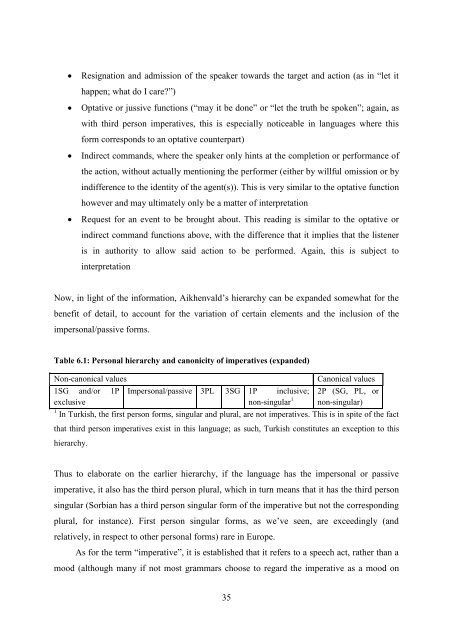The function of non-canonical imperatives in the languages of Europe
The function of non-canonical imperatives in the languages of Europe
The function of non-canonical imperatives in the languages of Europe
You also want an ePaper? Increase the reach of your titles
YUMPU automatically turns print PDFs into web optimized ePapers that Google loves.
Resignation and admission <strong>of</strong> <strong>the</strong> speaker towards <strong>the</strong> target and action (as <strong>in</strong> “let it<br />
happen; what do I care”)<br />
Optative or jussive <strong>function</strong>s (“may it be done” or “let <strong>the</strong> truth be spoken”; aga<strong>in</strong>, as<br />
with third person <strong>imperatives</strong>, this is especially noticeable <strong>in</strong> <strong>languages</strong> where this<br />
form corresponds to an optative counterpart)<br />
Indirect commands, where <strong>the</strong> speaker only h<strong>in</strong>ts at <strong>the</strong> completion or performance <strong>of</strong><br />
<strong>the</strong> action, without actually mention<strong>in</strong>g <strong>the</strong> performer (ei<strong>the</strong>r by willful omission or by<br />
<strong>in</strong>difference to <strong>the</strong> identity <strong>of</strong> <strong>the</strong> agent(s)). This is very similar to <strong>the</strong> optative <strong>function</strong><br />
however and may ultimately only be a matter <strong>of</strong> <strong>in</strong>terpretation<br />
Request for an event to be brought about. This read<strong>in</strong>g is similar to <strong>the</strong> optative or<br />
<strong>in</strong>direct command <strong>function</strong>s above, with <strong>the</strong> difference that it implies that <strong>the</strong> listener<br />
is <strong>in</strong> authority to allow said action to be performed. Aga<strong>in</strong>, this is subject to<br />
<strong>in</strong>terpretation<br />
Now, <strong>in</strong> light <strong>of</strong> <strong>the</strong> <strong>in</strong>formation, Aikhenvald’s hierarchy can be expanded somewhat for <strong>the</strong><br />
benefit <strong>of</strong> detail, to account for <strong>the</strong> variation <strong>of</strong> certa<strong>in</strong> elements and <strong>the</strong> <strong>in</strong>clusion <strong>of</strong> <strong>the</strong><br />
impersonal/passive forms.<br />
Table 6.1: Personal hierarchy and ca<strong>non</strong>icity <strong>of</strong> <strong>imperatives</strong> (expanded)<br />
Non-ca<strong>non</strong>ical values<br />
Ca<strong>non</strong>ical values<br />
1SG and/or 1P Impersonal/passive 3PL 3SG 1P <strong>in</strong>clusive; 2P (SG, PL, or<br />
exclusive<br />
<strong>non</strong>-s<strong>in</strong>gular 1 <strong>non</strong>-s<strong>in</strong>gular)<br />
1 In Turkish, <strong>the</strong> first person forms, s<strong>in</strong>gular and plural, are not <strong>imperatives</strong>. This is <strong>in</strong> spite <strong>of</strong> <strong>the</strong> fact<br />
that third person <strong>imperatives</strong> exist <strong>in</strong> this language; as such, Turkish constitutes an exception to this<br />
hierarchy.<br />
Thus to elaborate on <strong>the</strong> earlier hierarchy, if <strong>the</strong> language has <strong>the</strong> impersonal or passive<br />
imperative, it also has <strong>the</strong> third person plural, which <strong>in</strong> turn means that it has <strong>the</strong> third person<br />
s<strong>in</strong>gular (Sorbian has a third person s<strong>in</strong>gular form <strong>of</strong> <strong>the</strong> imperative but not <strong>the</strong> correspond<strong>in</strong>g<br />
plural, for <strong>in</strong>stance). First person s<strong>in</strong>gular forms, as we’ve seen, are exceed<strong>in</strong>gly (and<br />
relatively, <strong>in</strong> respect to o<strong>the</strong>r personal forms) rare <strong>in</strong> <strong>Europe</strong>.<br />
As for <strong>the</strong> term “imperative”, it is established that it refers to a speech act, ra<strong>the</strong>r than a<br />
mood (although many if not most grammars choose to regard <strong>the</strong> imperative as a mood on<br />
35
















